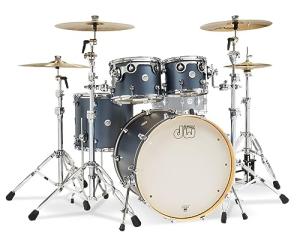Starting drums can feel overwhelming, especially if you’re short on time. A focused 30-minute daily practice routine helps new drummers build skills faster and with less frustration.
This routine is designed for home use and covers the most important basics.

With the right practice, anyone can improve coordination, timing, and musical expression on the drums. Consistent short routines build a solid foundation and keep learning fun.
Key Takeaways
- Short daily drum practice creates steady progress
- Routines cover technique, rhythm, and creativity
- Making drumming part of daily life leads to better results
Building a Solid Foundation
A strong practice routine starts with good habits. Every new drummer should focus on warming up, building stick control, and learning basic rudiments like the paradiddle for better coordination.
Essential Warmups
Warmups get your body ready for drumming and help prevent injuries. Always begin with a few minutes of stretching the wrists, fingers, and shoulders.
Next, do simple hand exercises—tap each hand on a practice pad or drum set for about a minute. This relaxes the muscles and gets the blood flowing.
Try playing single strokes (right, left, right, left) slowly. Once your hands feel comfortable, speed up a bit.
These warmups also help improve timing and focus before moving on to more complex skills.
Developing Stick Control
Stick control means you can move the sticks smoothly and hit where you want. Honestly, it’s one of the most important things to work on early.
Practice with a metronome. Play single strokes, double strokes (right, right, left, left), and mix up patterns at different speeds.
Start slow to build muscle memory. Gradually speed up in small steps to avoid mistakes.
Some examples of stick control exercises:
| Exercise | Pattern | Reps |
|---|---|---|
| Single Stroke Roll | R L R L R L R L | 1 min |
| Double Stroke Roll | R R L L R R L L | 1 min |
| Alternating Accents | R l R l L r L r | 1 min |
Use a practice pad to focus on evenness and grip. Consistent stick control practice leads to smoother playing and better limb coordination on the drum set.
Mastering the Basic Rudiments
Rudiments are the building blocks of drumming. They’re short, repeated patterns that every drummer should know.
The paradiddle is one of the most common and goes R L R R, L R L L. Practice this slowly and make sure each hit sounds the same.
Start on a practice pad, then move to the snare or drum set. Other key rudiments to learn early include the single stroke roll, double stroke roll, and flam.
Practicing these daily, even for just a few minutes, helps with control and independence between your hands. As you get more confident, try playing rudiments faster and sneaking them into real songs and drum beats.
Practicing Coordination and Rhythm

Learning to play drums well means having steady rhythm and the ability to control each limb separately. Focusing on coordination and timing builds a strong base for more complex skills later.
Playing with a Metronome
A metronome helps you keep a steady beat and work on tempo control. Beginners should start by setting the metronome to a slow speed, like 60-70 beats per minute.
Practice basic drum patterns with both hands and feet. Make sure each note lines up with the click.
Try using different note values—quarter notes, eighth notes—to get used to switching up rhythms. Pay attention to rests (the spaces between notes) to keep the beat clean.
Practicing with a metronome makes it easier to spot timing mistakes and fix them right away.
Tip: If a pattern feels too hard, slow the tempo until it’s comfortable.
Sample practice table:
| Min | Exercise |
|---|---|
| 5 | Quarter notes with a click |
| 5 | Eighth notes, slow tempo |
| 2 | Note and rest combinations |
Groove and Timekeeping Exercises
After working with a metronome, focus on keeping a solid groove. Playing simple rock or funk beats builds limb coordination and timekeeping.
Try leading with your right or left hand, and change which foot plays the bass drum. Practice cycling between basic grooves and patterns with different rhythmic ideas.
For example, switch between eight bars of a steady beat and four bars of silence (rests). Listen for gaps in time. Keeping the beat going during rests builds inner time and helps control rushing.
List of simple groove exercises:
- Standard 8th note rock beat (right hand on hi-hat, left on snare)
- Basic funk pattern with syncopated bass drum
- Alternating hands for each bar
Building confidence in these exercises helps you stay steady in any music style.
Exploring Drum Soloing and Musicality

New drummers can build musical skills by practicing simple soloing, listening to great performers, and using dynamics. This isn’t just about technique—it’s about finding your own voice on the kit.
Simple Improvisation Techniques
Drum solos are short pieces where you play alone. For beginners, improvising a solo can feel intimidating, but starting with simple ideas helps.
One basic technique is call and response. Play a rhythm on the snare, then answer with a different pattern on the toms.
Practice soloing with just a few elements at first. Try hands on the snare and hi-hat, then add the bass drum or cymbals.
Limit the time—maybe solo for 4 or 8 bars. Change up your sticking (which hand hits) and include basic rudiments like single strokes or doubles.
Staying in time is key. Set a metronome and improvise within a simple groove.
Write down a few favorite patterns to use again later. Mixing these ideas over time makes solos feel more musical and less random.
Listening to Drum Solo Recordings
One of the best ways to learn about drum solos as an art form is to listen to the masters. Famous drum solo recordings and videos give you new ideas for creativity and growth.
Pick a few drummers to study—Buddy Rich, Neil Peart, Sheila E.—and listen to how they use different drums, rhythms, and styles.
Take notes while watching recorded solos or live performances. Focus on the structure: how the solo starts, builds, and ends.
Notice if the drummer uses loud and soft sections, pauses, or repeats patterns. Some solos are flashy, some are simple and melodic.
By hearing lots of examples, you’ll find inspiration and start to figure out what works for you.
Incorporating Dynamics
Dynamics are changes in volume and intensity. A solo with only loud notes sounds flat, but changing levels adds feeling and interest.
Practice playing soft (piano), medium (mezzo), and loud (forte). Try soloing quietly for a few bars, then switch to louder patterns.
Use softer brush strokes, then switch to sticks. Accent certain beats while playing the rest quietly.
Create contrast by building up from a whisper to a strong finish. Dynamics help a solo feel more like music instead of just noise.
Good drummers use dynamics to make their solos stand out. Practicing these changes brings solos to life and makes them enjoyable to play and listen to.
Integrating Drumming into Daily Life
New drummers can build strong habits by adding drumming into their normal schedule. Practicing every day helps develop muscle memory and keeps progress steady.
Keeping a Consistent Daily Routine
Set aside the same 30 minutes each day to stay on track. Making a schedule and sticking to it—even when life gets busy—leads to better skills over time.
Some drummers use a simple checklist to keep themselves honest. Here’s an example:
| Day | Time | Practiced? (Y/N) |
|---|---|---|
| Monday | 6:30pm | |
| Tuesday | 6:30pm |
Even on days when you can’t use the drum kit, practicing on a pad or tapping out rhythms on a desk keeps you moving forward. Family support helps, too—let them know about your routine so they can give you space when you need it.
A few tips:
- Set up the drum kit or practice pad in a quiet, easy-to-reach spot.
- Keep sticks and practice materials nearby.
- Treat it like any important appointment.
Making Practice Fun and Sustainable
A routine needs to stay interesting, or you’ll get bored fast.
Switch things up—play on toms one day, mess with percussion patterns the next, or just try to copy a song from your favorite rock band. Playing along to music or backing tracks adds variety that keeps you on your toes.
New drumming exercises, or short jam sessions with friends or family, can make practice feel fresh again. Honestly, sometimes you just need a change to keep the spark alive.
Take short breaks during practice to avoid tired hands and keep your focus sharp. Got dreams of touring or joining a band? Mix those goals into your practice for an extra jolt of excitement.
Here are a few ways to keep it fun:
- Switch up what you practice every week.
- Play with others, in person or online. Why not?
- Set small goals you can actually reach, and celebrate when you do.
Frequently Asked Questions
Daily drum practice should focus on basic techniques and exercises for both hands. Timekeeping matters, too. Tracking progress with an app or old-school notes can help you see how far you’ve come and keep you motivated.
What are the essential components of a daily practice routine for beginner drummers?
Start with simple stick control drills to warm up your hands.
Practice basic rhythm patterns—quarter notes, eighth notes—to build your timing. Even if you’re just using a practice pad, work on coordination between hands and feet.
How can a practice pad be effectively utilized in a 30-minute daily drum routine?
A practice pad is great for working on stick grip and drum strokes without making a ton of noise.
Use it for rudiments like single strokes and double strokes. It’s perfect for focusing on technique and control, especially if you’re short on space or quiet is a must.
Which drumming exercises are recommended for building foundational skills?
Single stroke rolls help with speed and evenness.
Double stroke rolls build control and bounce. Paradiddles? They’re awesome for hand coordination and switching hands smoothly.
Can you suggest a structured 30-minute daily practice plan for a novice drummer?
Spend 5 minutes on warm-up stick exercises.
Use 10 minutes for basic rudiments. Then dedicate 10 minutes to playing simple beats or songs. Wrap up with 5 minutes of free play or going over tricky spots.
What tools or apps are best for tracking progress in a new drummer’s practice sessions?
Metronome apps are a must for steady timing.
Practice log apps like Modacity, or even just a note-taking app, let you jot down what you practiced. Some metronome and drumming apps will even track your speed—pretty handy if you ask me.
How frequently should a beginner incorporate rest days into their drumming practice schedule?
Most beginners do well with one or two rest days each week.
Taking breaks helps avoid hand and wrist strain. It also keeps your practice sessions feeling fresh.
DISCLAIMER
This document is provided for general information purposes only and should not be relied upon as providing legal advice, technical, or specific operational guidance to the reader, whether as to the practices described in the document or the applicable legal requirements and regulations. Percussion Pros expressly disclaims any responsibility for liability arising from or related to the use or misuse of any information in this document.





